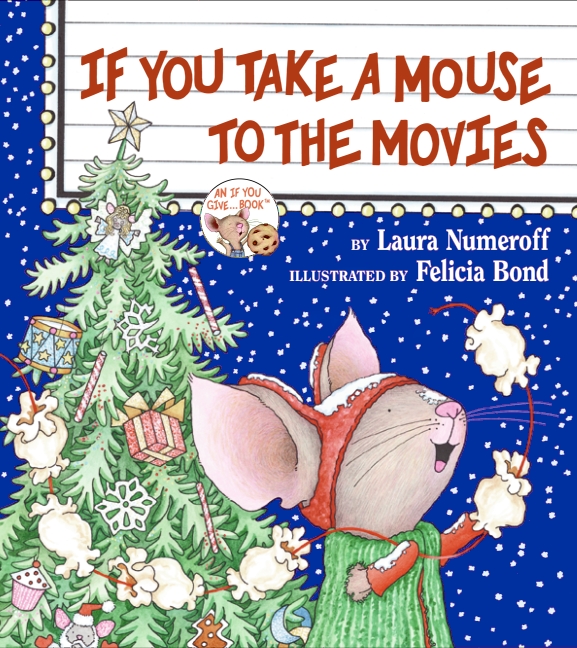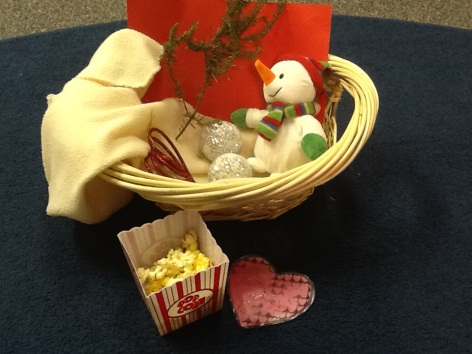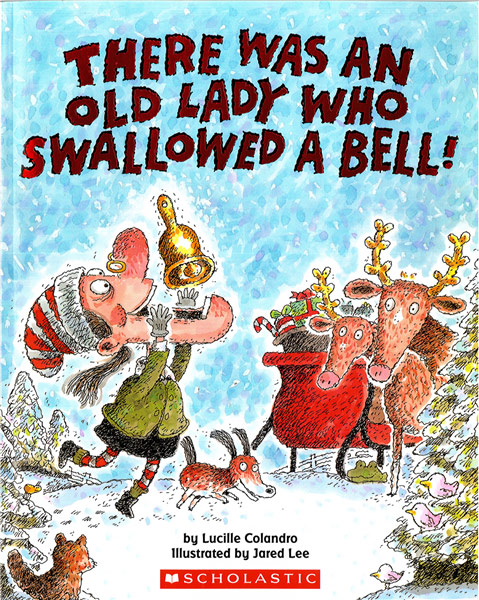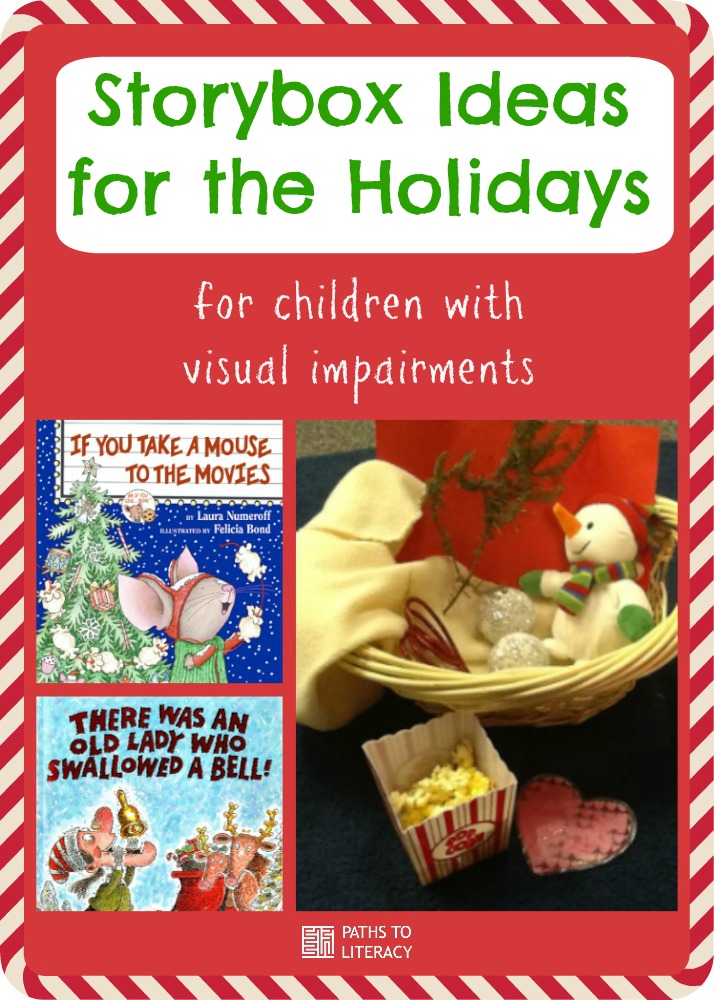Story Box Ideas for Holiday Stories
by Jaime Brown and Katie Armstrong, Preschool Teachers at the Foundation for Blind Children, Phoenix, Arizona. (Editor's note: Jaime and Katie both teach children who are blind or visually impaired and Jaime's class includes children with additional disabilities. Both have included ideas and adaptations for their different groups of children, according to the needs of the students.)
 Jaime writes:
Jaime writes:
The holiday season offers many opportunities to explore new concepts, introduce new objects, and reinforce newly acquired skills. Children’s books introduce holiday themes in an entertaining manner. There are many different holiday stories that can be adapted for children with different levels of abilities and visual impairments. I am highlighting two stories that can easily be incorporated into holiday lesson plans. If You Take A Mouse to the Movies, By Laura Numeroff and There was an Old Lady Who Swallowed a Bell, by Lucille Colandro. The students in my class prefer silly stories. Currently, their favorite is and There was an Old Lady Who Swallowed a Bell.
Storyboxes are appropriate to use with all students. Children with multiple disabilities enjoy Storyboxes and stories. They can benefit from exploring the real objects represented in the story. Whenever possible, textures in the story should be partial textures from the real objects used in the storybox. Students should have the opportunity to explore storybox items individually to enhance their learning and understanding of the objects. These common items can be easily gathered from home, your classroom or the grocery store.
Make the Story as Interactive as Possible
As you read the story, make it as interactive as possible. For example, the students can turn on the radio using a switch. They can vocalize into the microphone to sing along. They can hang the ornament on the tree, throw snowballs, and feel the blanket on their lap. Encourage the students to use all of their senses to touch, smell and taste. As you read each page, allow each student to feel and explore the object. For students with shorter attention spans or energy levels, shorten the story. Another strategy is to have multiples of each object so that they have shorter times to wait for their turn.
Provide Frequent Opportunities for Students to Explore Storybox Items
Students should have frequent opportunities to explore and play with storybox items, until they become familiar. Then, when later on a student hears the names of the items they will have a memory of the item. For example, when they hear popcorn they know how it feels, smells, looks, tastes etc. To increase their time to explore items, consider making a story toy bar. Hang a blanket, a musical toy, tree branches, ornaments, and other items from the story. (For If You Take a Mouse to the Movies)
Storybox items needed for If You Take A Mouse to the Movies
- Movie (use an iPad or Smart Tablet to show a movie clip)
- Popcorn
- Yarn or string
- Small Christmas tree (real or artificial, depending on allergies)
- Snow: real or man-made, depending on resources
- Snowman*
- Carrot
- Cardboard for fort
- Snowball
- Blanket
- Radio, CD player or switch with pre-recorded carols
- Toy Microphone
- Paper, glitter, glue
- Ornament
*To make a snowman without using snow, insert an ice pack in white washcloth rolled into balls. This also works for snowballs.
Concepts introduced in this book:
- If/then.
- Next
- Cold/Warm
These stories can be used as the foundation of the season’s lesson plans.
Art/Sensory:
Play in snow. Place snow on a work tray. This gives you the ability to place the snow within the student’s reach. Encourage your students to explore the snow, and describe its properties. Pop popcorn with your class. Play with the popcorn and then create a popcorn collage.
Social:
Decorate a tree as a class. Using as much or as little assistance as needed, students can string the lights and garland. They can hang ornaments. Whenever possible, give the students as many choices as possible: which ornament to hang, the garland color.
Language/Communication:
Singing/vocalizing into a microphone. Model how to use the microphone and sing along with a song. Choice making- encourage the students to choose an activity such as listening to songs, playing with the popcorn
Vision/Compensatory:
Looking at lights and ornaments. The students can turn the lights on and off using a switch. In my classroom, I have set up two Invisiboards and connected the lights to a select switch. The students can independently turn the lights on and off. Many students in my class have chosen to listen to songs while looking at the lights.
Give the students repeated opportunities to tactually explore the tree and the ornaments. If you are able, bring in real branches from a pine tree.
Physical Development:
Encourage the students to touch the snow, picking it up and maintaining their grasp on a snowball. Throwing snowballs using assistance as needed.
Cognitive:
Students can work on identifying a tree and increasing their knowledge base about seasonal items. Concepts introduced in this book: If/then, next, cold/warm.
Katie adds:
I kicked off the week by reading If You Take a Mouse to the Movies by Laura Numeroff, using the same story box that Jaime described. I added braille to my print book (well, lines of braille dots... I heard recently of a teacher who put lines of dots 1,3,4 and 6 which kind of makes a trough for your fingers to help promote tracking, so I gave it a shot). I always read my stories with the entire class then leave the book and story box out for individual readings with an adult, or for the children to just explore, and explore they did!!
We continued on with activities that corresponded to the story. Read more about those in my next blog post later this week...
Storybox Items Needed for  There Was An Old Lady Who Swallowed a Bell!
There Was An Old Lady Who Swallowed a Bell!
- Bells
- Velvet Bows
- Gift (The dollar store has wrapped boxes)
- Sack
- Sleigh (I used a toy sleigh)
- Toy reindeer or reindeer picture with fur
- Candy Canes
- Santa Hat/Santa Beard
- Recorded Sounds
At the beginning of the story, provide each child with a set of bells. Introduce the repeating line in this story: …The Bell that jingled and jangled and tickled as well. Demonstrate how to ring the bells. Each time this line is repeated, encourage the students to ring their bells.
The old lady in the story almost tastes a candy cane. For the students that can taste, have them taste the candy canes. For students who can’t taste, allow them the opportunity to smell and touch the candy cane
This story has very busy pictures that can be difficult for many children to see. When I read this story in class, I read the story and presented the storybox items. I made an adapted copy of the story that had the words in print/braille and the object on the page. The students used the adapted copy to explore the textures in the book.
Art/Sensory:
Create a peppermint tray. Encourage the students to touch, taste and smell a candy canes of varying shapes and sizes. They can also fingerpaint on paper using red paint, scented with peppermint.
Social:
Encourage students to participate in parallel or cooperative play activities. As a small or large group, they can put items into the sleigh and take them back out. They can also play the “Reindeer Hokey Pokey”. Each student takes a turn choosing the movement (antlers, hooves, noses)
Language:
Students can help repeat the phrase “that jingled and jangled and tickled as well” by using a pre-recorded voice output device, by vocalizing, or by speaking.
Vision/Compensatory:
This story has many red objects. Students can look for the red object and maintain their gaze (red bows, red sleigh, red Santa Suit). Red rope lights, peppermint lights and stocking lights are fun to view. Place the red objects on invisiboards; Velcro red stockings on one board, candy canes on another board, etc.
Physical Development:
Playing with bells offer many opportunities to work on fine and gross motor development. Students can work on grasping bells from a flat surface, picking them up, maintaining their grasp and ringing the bells.
Cognitive:
Introduce and reinforce concepts addressed in the story. The color red, identify objects in the story, identify Santa. Create a tray using the storybox items for students to feel and explore. Identify each item for them. As they increase their familiarity, ask them to find an object using eye gaze, reaching or touching.
For more information about Story Boxes, see also: Story Box Ideas from Norma Drissel

